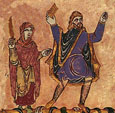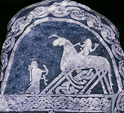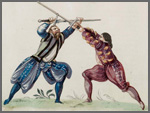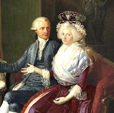Lothene's Craft Activities
In Early Medieval times, thread was made on a drop spindle. Wool or linen (rarely silk) was first cleaned and combed so as to line up the fibres. It was then pulled out into a narrow strand which was twisted up by dropping and spinning the spindle. In order to make multiple plies of thread several spindles were needed. Single threads were spun with a twist in one direction, and then these were spun together onto a new spindle using an opposite twist. Several miles of thread are required to make even a simple tunic. The textile industry generally seems to have been women's work, and a source of independent income for them, but there are records of men, even Earls, spinning thread for domestic use. |
 |
|
 |
Tablet weaving was used to make borders for cloth and also such things as belts and straps. In normal weaving, two sets of warp threads are used. In tablet weaving rotating cards are used to allow four or more sets. Skilled tablet weavers can produce complex patterns, and even writing. The frame is used to keep the weaving tension even, but it is not necessary. One end of the weaving can be tied to a belt and the other to, for example, a door post. |
|
Sprang is a method of making a flexible fabric. It was widely used for garments such as stockings and hairnets until knitting replaced it. A single thread is wound up and down as a warp and is then plaited together in various patterns without using a weft thread. This produces two pieces of fabric which grow towards each other from opposite ends of the loom. If this is continued until they meet the resulting item is symmetrical about the centre. Otherwise two mirror image items (e.g. a pair of stockings) result. |
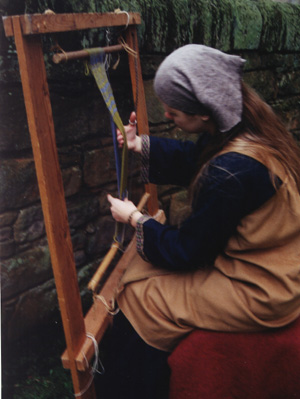 |
|
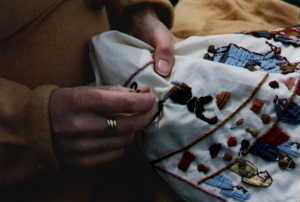 |
The Saxons were famous for their intricate embroidery. The Vikings tended to use more simple geometric patterns. The Bayeux tapestry is the best known surviving example of Saxon style embroidery, although it was commisioned by a Norman. The Oseberg ship tapestry is an example of Viking embroidery. |
|
This pouch is made from a single piece of leather which is gathered up and tied with a thong. A flap covers the opening. The belt is also leather and has a semi-circular bronze buckle and a bronze tag at the end. The beads are "mille fiori" made by twisting strands of different coloured glass together. Both men and women wore jewellery such as necklaces, rings and brooches. Necklaces were usually an assortment of beads and pendants. The brooches were used to fasten tunics and cloaks. |
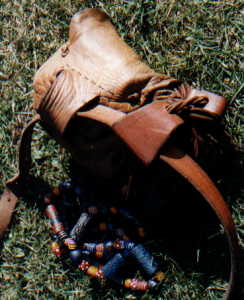 |
|
 |
A cauldron over an open fire can be used to produce quite an elaborate meal. Metal and pottery containers could stand in the boiling water to cook their contents, and cloth bags of vegetables could be cooked separately in the water. Items could also be steamed above the cauldron. Flat griddles and grills could also be used over an open fire. Heat is regulated by raising or lowering the cauldron above the fire. A bed of embers, rather than direct flame gives a good source of heat. A fire pit can be shaped so as to have one area where the fire is burning and another area to which embers are raked for use in cooking. |
|
| The interior of the turf oven is made of stones. A single large, flat stone is laid across the top. The oven is then insulated with turf. The top stone may be covered, or alternatively may be left clear for use as a hot plate. A fire is lit in the oven and is then removed to allow the oven to be used when it has reached the right temperature. Ovens in buildings work in a similar way. They are built into a wall and heated with a fire which is then removed before the oven is used. In this case the wall rather than turf acts as the insulation. Many medieval castles have the remains of ovens in their kitchens. |
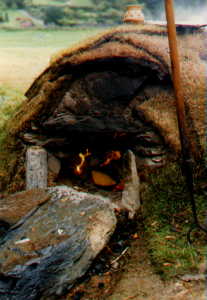 |
|
Other arts and crafts practiced by members of Lothene include wood block printing, calligraphy, illumination, metal jewllery making, naalbinding, woodwork, dancing, music, mail making, blacksmithing and pottery.
|
||
Useful LinksEarly Medieval Textiles in Scotland and Ireland Bibliography"The Viking" - Bertil Almgren and other authors - Nordbok - 91 7442 003 8 Lothene Experimental Archaeology Group are available for displays, talks and educational visits - contact us for details |
||

